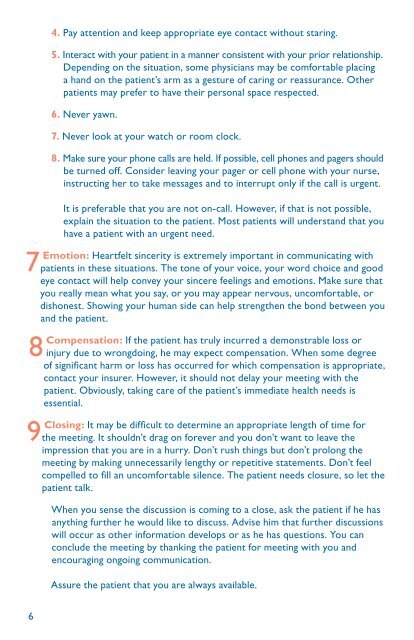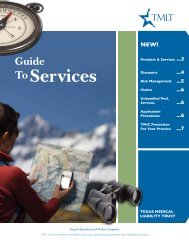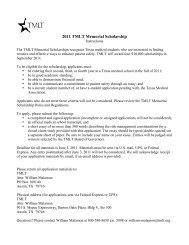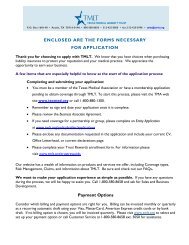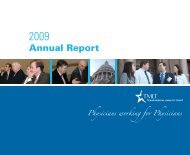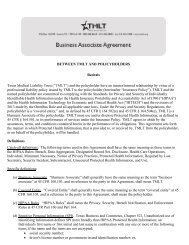Medical errors, disclosure, and the role of apology: a tool for ... - TMLT
Medical errors, disclosure, and the role of apology: a tool for ... - TMLT
Medical errors, disclosure, and the role of apology: a tool for ... - TMLT
You also want an ePaper? Increase the reach of your titles
YUMPU automatically turns print PDFs into web optimized ePapers that Google loves.
4. Pay attention <strong>and</strong> keep appropriate eye contact without staring.<br />
5. Interact with your patient in a manner consistent with your prior relationship.<br />
Depending on <strong>the</strong> situation, some physicians may be com<strong>for</strong>table placing<br />
a h<strong>and</strong> on <strong>the</strong> patient’s arm as a gesture <strong>of</strong> caring or reassurance. O<strong>the</strong>r<br />
patients may prefer to have <strong>the</strong>ir personal space respected.<br />
6. Never yawn.<br />
7. Never look at your watch or room clock.<br />
8. Make sure your phone calls are held. If possible, cell phones <strong>and</strong> pagers should<br />
be turned <strong>of</strong>f. Consider leaving your pager or cell phone with your nurse,<br />
instructing her to take messages <strong>and</strong> to interrupt only if <strong>the</strong> call is urgent.<br />
It is preferable that you are not on-call. However, if that is not possible,<br />
explain <strong>the</strong> situation to <strong>the</strong> patient. Most patients will underst<strong>and</strong> that you<br />
have a patient with an urgent need.<br />
Emotion: Heartfelt sincerity is extremely important in communicating with<br />
7 patients in <strong>the</strong>se situations. The tone <strong>of</strong> your voice, your word choice <strong>and</strong> good<br />
eye contact will help convey your sincere feelings <strong>and</strong> emotions. Make sure that<br />
you really mean what you say, or you may appear nervous, uncom<strong>for</strong>table, or<br />
dishonest. Showing your human side can help streng<strong>the</strong>n <strong>the</strong> bond between you<br />
<strong>and</strong> <strong>the</strong> patient.<br />
Compensation: If <strong>the</strong> patient has truly incurred a demonstrable loss or<br />
8 injury due to wrongdoing, he may expect compensation. When some degree<br />
<strong>of</strong> significant harm or loss has occurred <strong>for</strong> which compensation is appropriate,<br />
contact your insurer. However, it should not delay your meeting with <strong>the</strong><br />
patient. Obviously, taking care <strong>of</strong> <strong>the</strong> patient’s immediate health needs is<br />
essential.<br />
Closing: It may be difficult to determine an appropriate length <strong>of</strong> time <strong>for</strong><br />
9 <strong>the</strong> meeting. It shouldn’t drag on <strong>for</strong>ever <strong>and</strong> you don’t want to leave <strong>the</strong><br />
impression that you are in a hurry. Don’t rush things but don’t prolong <strong>the</strong><br />
meeting by making unnecessarily lengthy or repetitive statements. Don’t feel<br />
compelled to fill an uncom<strong>for</strong>table silence. The patient needs closure, so let <strong>the</strong><br />
patient talk.<br />
When you sense <strong>the</strong> discussion is coming to a close, ask <strong>the</strong> patient if he has<br />
anything fur<strong>the</strong>r he would like to discuss. Advise him that fur<strong>the</strong>r discussions<br />
will occur as o<strong>the</strong>r in<strong>for</strong>mation develops or as he has questions. You can<br />
conclude <strong>the</strong> meeting by thanking <strong>the</strong> patient <strong>for</strong> meeting with you <strong>and</strong><br />
encouraging ongoing communication.<br />
Assure <strong>the</strong> patient that you are always available.


